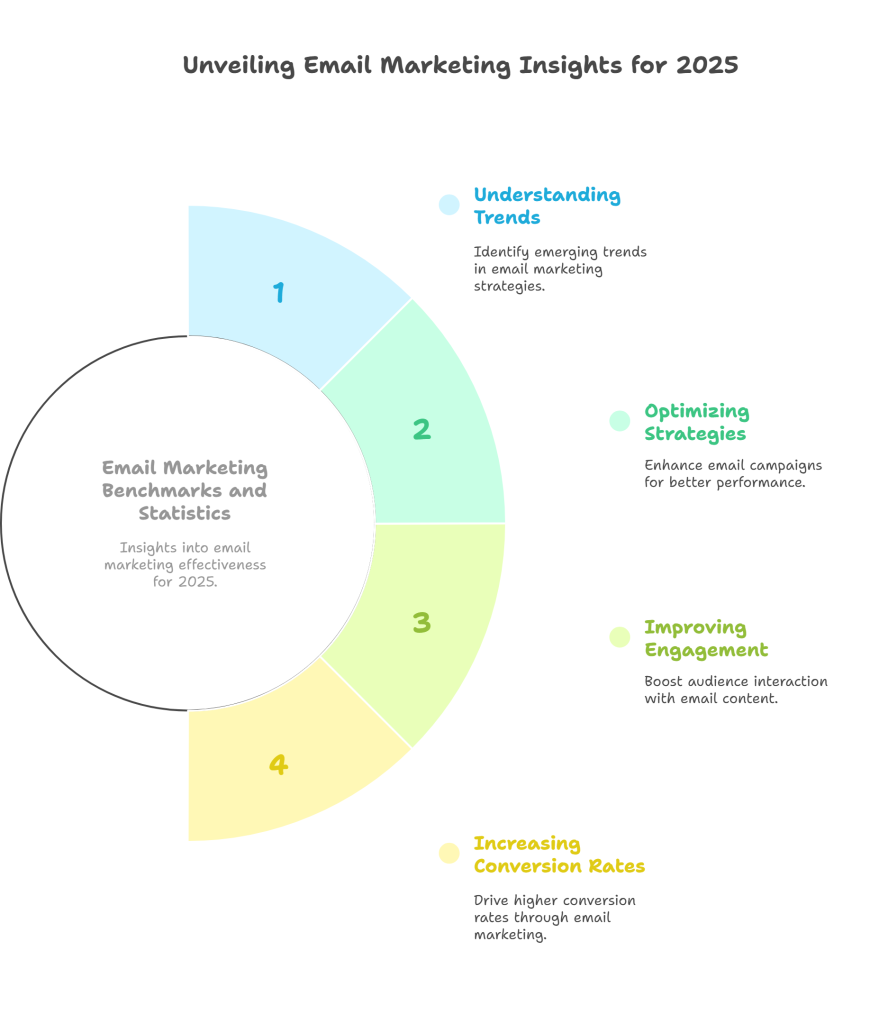In an age of ever-shifting digital trends, why does email marketing continue to reign supreme, delivering an average ROI of $36 for every $1 spent? While social media algorithms evolve and advertising costs fluctuate, the direct, personal connection offered by email remains an unparalleled asset for businesses.
However, the landscape of email marketing is far from static. With the increasing impact of privacy regulations, the rapid advancement of artificial intelligence, and evolving consumer expectations, staying ahead requires more than just sending out newsletters.

This article will provide comprehensive email marketing benchmarks and statistics for 2025, offering actionable insights and highlighting key trends to help marketers optimize their strategies for higher engagement and ROI.
Understanding the Core Email Marketing Metrics (2025 Benchmarks)
To effectively optimize your email marketing ROI in 2025, it’s crucial to understand the key performance indicators (KPIs) that truly matter. Comparing your performance against up-to-date industry email marketing benchmarks 2025 is the first step toward identifying areas for improvement and celebrating successes.
Open Rate
The email open rate 2025 defines the percentage of recipients who open your email. It’s calculated by dividing the number of unique opens by the number of emails delivered. While still a valuable metric, its interpretation has become more nuanced due to privacy changes like Apple’s Mail Privacy Protection, which can skew figures.
Factors influencing open rates include the strength of your subject line, your sender reputation, and the time of day you send. For 2025, the overall average open rate stands at approximately 42.35% as per MailerLite data. However, this varies significantly by industry:
| Industry | Average Open Rate (2025) |
| Health & Fitness | 48.9% |
| Non-profit | 48.0% |
| Government | 46.4% |
| Education | 45.1% |
| Marketing & Advertising | 36.5% |
| E-commerce | 31.08% |
Click-Through Rate (CTR)
The email click-through rate 2025 measures the percentage of recipients who click on one or more links contained in your email. It’s calculated by dividing the number of unique clicks by the number of emails delivered. CTR is a stronger indicator of engagement than open rate alone, as it signifies active interest in your content.
The average CTR for 2025 hovers around 2.00% globally, according to MailerLite. Strategies to improve CTR include crafting compelling calls to action (CTAs), ensuring your content is highly relevant, and clearly communicating the value proposition of clicking.
| Industry | Average CTR (2025) |
| Non-profit | 3.25% |
| Education | 2.80% |
| Government | 2.75% |
| Health & Fitness | 2.50% |
| Marketing & Advertising | 1.80% |
| Retail | 1.50% |
Click-to-Open Rate (CTOR)
The Click-to-Open Rate (CTOR) offers a more refined measure of engagement by taking into account only those who opened your email. It’s calculated by dividing unique clicks by unique opens. This metric helps assess how effective your email’s content and design are at converting an open into a click.
For 2025, the average CTOR across industries is around 5.63% (MailerLite). A higher CTOR indicates that your email’s content successfully captured the attention of those who opened it.
Conversion Rate
The email conversion rate 2025 is arguably the most critical metric, measuring the percentage of recipients who complete a desired action after clicking a link in your email, such as making a purchase, signing up for a webinar, or filling out a form. It focuses on tangible outcomes rather than just engagement.
While industry averages vary widely based on the product/service and campaign type, typical email conversion rates for 2025 range between 2% and 5% across all industries. For instance, automated welcome sequences or abandoned cart emails often see significantly higher conversion rates (e.g., 10-15%) compared to general promotional newsletters due to their highly targeted nature.
This metric is increasingly crucial in a privacy-first world where open rates are less reliable, making conversion tracking the ultimate measure of success.
Bounce Rate
The email bounce rate 2025 represents the percentage of emails that couldn’t be delivered to the recipient’s inbox. This can be categorized into “soft bounces” (temporary issues like a full inbox) and “hard bounces” (permanent issues like an invalid email address).
For 2025, the overall average bounce rate is approximately 2.48%. Maintaining a low bounce rate is paramount for your email deliverability 2025 and sender reputation. Regular list hygiene – removing inactive or invalid addresses – is essential to prevent your emails from being flagged as spam by internet service providers (ISPs).
Unsubscribe Rate
The unsubscribe rate is the percentage of recipients who opt out of your email list after receiving an email. For 2025, the average unsubscribe rate is around 0.89%. While no one wants to see unsubscribes, a certain percentage is normal and can even indicate a healthier list as disengaged subscribers self-select out.
High unsubscribe rates might suggest issues with email frequency, irrelevant content, or a mismatch between subscriber expectations and actual content.
Email Marketing ROI
The ultimate measure of email marketing success is its Return on Investment (ROI). For 2025, email marketing ROI 2025 continues to demonstrate its power, delivering an impressive average of $36 for every $1 spent. This figure underscores email’s efficiency and effectiveness compared to many other marketing channels.
Industries like Retail, E-commerce, and Consumer Goods often report even higher ROIs due to direct sales attribution and repeat customer engagement. Factors contributing to high ROI include strong segmentation, compelling offers, effective A/B testing, and automation.
Key Email Marketing Trends Shaping 2025 Performance
The digital marketing landscape is dynamic, and email marketing trends 2025 are pushing the boundaries of what’s possible. Staying abreast of these developments is critical for maximizing your campaign effectiveness.
Hyper-Personalization and Advanced Segmentation
Beyond simply using a subscriber’s first name, email personalization 2025 is evolving into hyper-personalization. This involves leveraging rich behavioral data, past purchase history, Browse patterns, and even predictive analytics powered by AI to deliver highly relevant and timely content.
For instance, sending a targeted email with product recommendations based on a user’s recent website activity or a follow-up after a specific time since their last purchase. Studies consistently show that personalized emails yield significantly higher engagement, with some reports indicating up to a 29% higher open rate and 41% higher CTR.
Advanced email segmentation 2025 allows marketers to group subscribers into granular cohorts based on their unique characteristics and behaviors, enabling truly tailored communication through triggered emails and dynamic content.
The Rise of AI in Email Marketing
Artificial Intelligence is no longer a futuristic concept; it’s actively revolutionizing various aspects of email marketing. From content creation to optimization, AI in email marketing 2025 is becoming indispensable:
- AI for Content Creation: Tools leveraging AI can assist in generating compelling subject lines, crafting engaging body copy, and even suggesting optimal calls to action, saving marketers significant time and effort.
- AI for Send-Time Optimization: AI algorithms can analyze historical data to predict the best time to send emails to individual subscribers, maximizing open and click rates.
- AI for Predictive Analytics: AI can forecast customer behavior, identifying subscribers most likely to churn or make a purchase, allowing for proactive, targeted interventions.
- AI for Automated A/B Testing: AI can automatically test multiple variables (subject lines, visuals, CTAs) and learn what resonates best with specific audience segments, optimizing campaigns in real-time.
For example, tools like Shopify Magic and HubSpot’s AI CRM email features are already demonstrating how AI can streamline and enhance email campaign creation and management, leading to improved performance.
Interactive Email Content (AMP for Email, Gamification)
Static emails are becoming a thing of the past. Interactive email content 2025 is gaining traction, allowing users to engage directly within the inbox without needing to navigate to a landing page. This includes elements like quizzes, polls, image carousels, embedded videos, and even basic mini-games.
This direct engagement significantly boosts user experience and can lead to higher conversion rates. Data suggests that interactive content can lead to a 73% higher click-to-open rate, highlighting its effectiveness in capturing and maintaining subscriber attention.
Beyond direct engagement, interactive elements can also be used for subtle gamification, further increasing participation and brand recall.
Privacy-First Marketing and Deliverability
With stringent regulations like GDPR and CCPA, and platform changes like Apple Mail Privacy Protection (MPP), a privacy-first approach is non-negotiable for email deliverability 2025. Marketers must prioritize explicit consent, transparent data practices, and clear communication about data usage.
While MPP has impacted the reliability of open rates as a standalone metric, it reinforces the need to focus on deeper engagement metrics like CTR and conversion rate. Strategies to maintain high deliverability include rigorous list hygiene, utilizing email authentication protocols (SPF, DKIM, DMARC) to verify sender identity, and monitoring sender reputation closely to avoid being blacklisted by ISPs.
Mobile-First Design and Accessibility
Given that a significant percentage of emails (over 41%) are now opened on mobile devices, mobile-first design is no longer optional; it’s a fundamental requirement. Emails must be fully responsive, adapting seamlessly to various screen sizes and orientations.
Beyond responsiveness, email accessibility 2025 is paramount, ensuring your emails are usable and understandable by everyone, including those with disabilities. This involves using appropriate font sizes, high-contrast colors, clear alt text for images, and logical content structure.
Omnichannel Integration
In 2025, successful email marketing isn’t an isolated effort. It’s seamlessly integrated into a broader omnichannel marketing strategy. This involves ensuring a consistent and personalized brand experience across all touchpoints, including social media, SMS, in-app messaging, and customer service interactions.
For instance, a customer who views a product on your website but doesn’t purchase might receive an email reminder, followed by a targeted ad on social media. This unified approach creates a holistic customer journey, enhancing brand loyalty and conversion potential.
Strategies to Outperform the Benchmarks in 2025
Understanding the benchmarks and trends is just the first step. To truly excel and maximize your email marketing ROI 2025, you need actionable strategies.
Data-Driven Segmentation and Personalization
To achieve hyper-personalization, you must first master data collection and segmentation.
- Leverage Zero- and First-Party Data: Gather data directly from your subscribers through preference centers, surveys, website behavior, and purchase history. This proprietary data is invaluable for crafting highly relevant messages.
- Develop Detailed Buyer Personas: Create comprehensive profiles of your ideal customers, understanding their demographics, psychographics, pain points, and motivations.
- Implement Advanced Segmentation: Go beyond basic demographic segmentation. Segment by purchase history, website engagement (e.g., visited product page but didn’t buy), email interaction (e.g., clicked specific links in past emails), and customer lifecycle stage.
Leveraging AI for Optimization
Embrace the power of AI to refine your email campaigns:
- Integrate AI Tools: Explore email marketing platforms and third-party tools that offer AI-powered features for content generation, send-time optimization, and predictive analytics.
- Human Oversight and Iterative Testing: While AI is powerful, it’s a tool. Always maintain human oversight to ensure brand voice consistency and ethical considerations. Use AI to generate hypotheses, then test them rigorously. For example, use AI to generate five different subject lines, then A/B test them to see which performs best.
Crafting Engaging and Interactive Content
To boost engagement and email click-through rate 2025:
- Incorporate Interactive Elements: Experiment with polls, quizzes, image carousels, and even simple games directly within your emails using technologies like AMP for Email.
- Embrace Storytelling and Visuals: Use compelling narratives and high-quality images and videos to make your emails visually appealing and emotionally resonant.
- Optimize for All Devices: Ensure your designs are fully responsive and accessible across all devices and email clients. Test on various platforms to guarantee a seamless user experience.
Focus on Deliverability and Trust
High deliverability is the bedrock of successful email marketing.
- Maintain a Clean Email List: Regularly remove inactive subscribers, hard bounces, and unsubscribes to improve your sender reputation and reduce bounce rates. Consider using re-engagement campaigns for inactive subscribers before removing them.
- Authenticate Your Emails: Implement SPF, DKIM, and DMARC records to verify your sender identity and prevent spoofing, which significantly boosts trust with ISPs and improves inbox placement.
- Monitor Sender Reputation: Use tools to monitor your sender score and address any issues promptly. A strong sender reputation is crucial for ensuring your emails land in the inbox, not the spam folder.
Consistent A/B Testing and Analytics
Continuous improvement hinges on rigorous testing and data analysis.
- A/B Test Everything: Experiment with different subject lines, calls to action, email lengths, visual layouts, and send times. Small tweaks can lead to significant gains. For example, test two different email layouts – one heavily text-based and one with more visuals – to see which yields higher engagement.
- Analyze Beyond Vanity Metrics: While open rates offer some insight, prioritize analyzing your CTR, CTOR, and most importantly, your conversion rate and overall ROI. These metrics provide a clearer picture of your campaign’s true effectiveness.
Conclusion: Seizing the Opportunity in 2025
The world of email marketing in 2025 is characterized by data, personalization, and intelligent automation. Understanding the latest email marketing benchmarks and statistics for 2025 is fundamental, but merely knowing them isn’t enough.
The true competitive advantage lies in strategically adapting to new trends – embracing AI in email marketing, mastering advanced personalization, deploying interactive email content, and prioritizing a privacy-first approach. By focusing on these areas and continuously testing your strategies, you can not only meet but far exceed industry standards.


